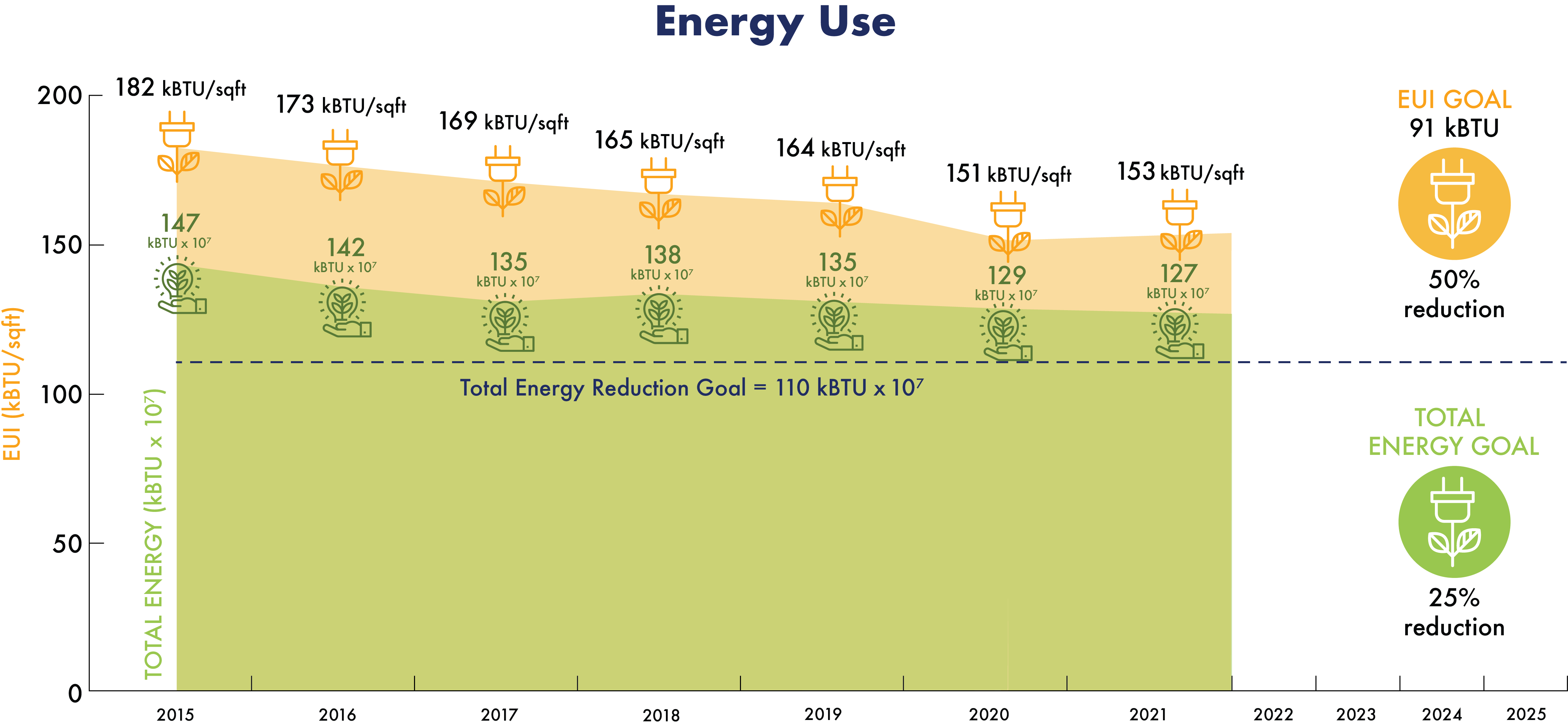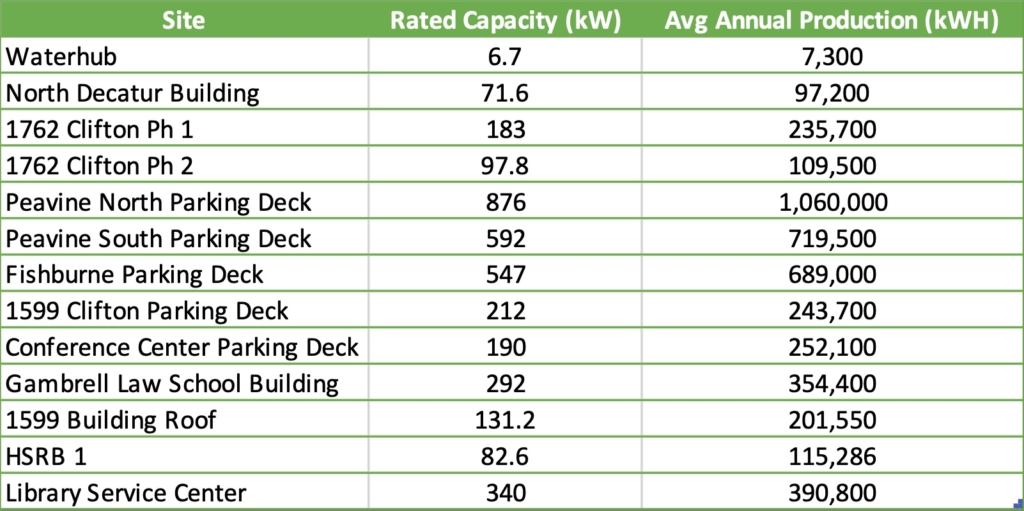Electricity production is the second largest source of greenhouse gas emissions in the United States, representing 25% of 2022 emissions (U.S. EPA). In 2021, natural gas and coal contributed to approximately 60% of Georgia’s total electricity net generation (EIA). Because of the public health and climate impacts of fossil fuel use, Emory’s 2025 Sustainability Vision focuses on energy efficiency and the increased use of renewable energy to mitigate climate change and improve air quality. Achieving this goal will require everyone – from administrators investing in energy-efficient systems to individuals changing their habits by turning off lights and computers – to commit to reducing our collective energy footprint.
So Far
- In 2023, Emory achieved an energy use intensity (EUI) reduction of 14.8% and a total energy use reduction of 10.8% from a 2015 baseline.
- In 2020, Emory signed a transformative solar power agreement with Cherry Street Energy. In doing so, Emory pledged to install more than 15,000 solar panels across 16 buildings on its Druid Hills campus, which will generate approximately 10 percent of Emory’s peak energy requirements and reduce Emory’s greenhouse gas emissions by about 4,300 metric tons.
- Since 2015, Emory has achieved an overall energy use per square foot (EUI) reduction of 15.3% and an overall total energy reduction of 14.1%. Read more about Emory’s energy usage in the Energy Efficiency page and in the 2023 Annual Energy & Utilities Report.
- Renewable energy is on the rise at Emory. In 2023, Emory has installed ten solar projects with a combined capacity of 3.6 MW. In 2023, Emory’s solar projects produced over 4,094 MWh of electricity. That is equal to the electricity used in powering 337 homes for one year!
- The Emory Student Center harnesses energy from solar panels to preheat potable water and uses a system of geothermal wells to help heat and cool the facility.
- Emory is enrolled in the Department of Energy’s Smart Lab Accelerator program, which works to advance strategies that rapidly improve energy efficiency in laboratory buildings. In 2019 Emory was acknowledged for its outstanding participation in the program by surpassing the 5% reduction target with a 7.2% reduction in one lab building’s energy use over two years.
- Emory uses Fault Detection and Diagnostics (FDD) to identify anomalies in equipment and system operation that in most cases can be corrected remotely through the building controls system or in some cases results in required field corrections.
- Emory University and Emory Healthcare participated in the Atlanta Better Buildings Challenge, a national competition to reduce energy and water consumption by 20 percent by 2020. Each year, Emory buildings were recognized as Top Performers.
- Emory continues to support in-house commissioning of campus projects and recommissioning of existing buildings. Recommissioning is a strategic process that optimizes existing building systems to return them to their originally commissioned state where possible. Recommissioning is currently the major driver of the EUI reductions for the University.
- Further information regarding Emory’s efforts to reduce carbon emissions from energy use can be found in the FY2023 Greenhouse Gas Emissions Inventory Report. The full report can be viewed here.
 Click image for a larger view
Click image for a larger view
Emory’s 2025 Vision goal is to reduce energy use per square foot by 50% in University buildings and 25% in Healthcare buildings. This graph shows progress toward the University goal in buildings on the Druid Hills and Oxford campuses.
Today
- Emory currently has a steam turbine generator and on-site solar arrays that have a combined capacity of over 4.5 MW.
- A 1 mW combined heat and power system operates in Emory’s steam plant. This system recovers mechanical heat produced by Emory’s natural gas generators.
- Emory’s $1.5million Sustainability Revolving Fund supports energy efficiency projects.
- Emory’s Sustainable Performance Program (SPP) strives to keep building HVAC systems optimized and prevent performance degradation.
- A temperature control policy and weekend, evening, and holiday building shutdowns decrease energy consumed to heat and cool Emory’s buildings, which are Emory’s largest stationary source of energy use.
$853k
and 12.4 million KWh saved by converting parking deck lights to LEDs as of 2020.
$132K
saved in energy costs during the 2023 holiday building turndown.
4094 MWh
produced from Emory’s solar projects in 2023.
Tomorrow
Emory is committed to reducing energy consumption and meeting building expansion, design, and construction standards. By 2025, Emory strives to:
- Reduce campus energy use per square foot by 50 percent and total energy use by 25 percent.
- Reduce Emory Healthcare energy use by 25 percent.
- Self-generate 10 percent of campus energy to replace fossil fuel sources.
- Incorporate major building renovations into LEED silver commitment or higher and attain best practices for sustainable performance in building interiors.
- Incorporate regenerative architectural standards such as net zero impact and “living building” in the new Campus Life Center and other innovative facilities.
- Reduce campus water consumption by 50 percent.
Completed Solar Projects:

Locations Under Design:
- Musculoskeletal Parking Deck Canopy
Locations to be designed that are included in SEPA:
- Starvine Parking Deck
- Lowergate East Parking Deck
- Lowergate South Parking Deck
